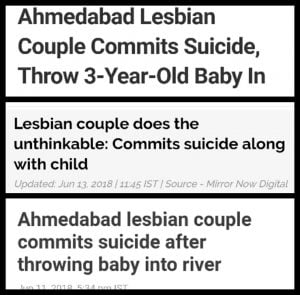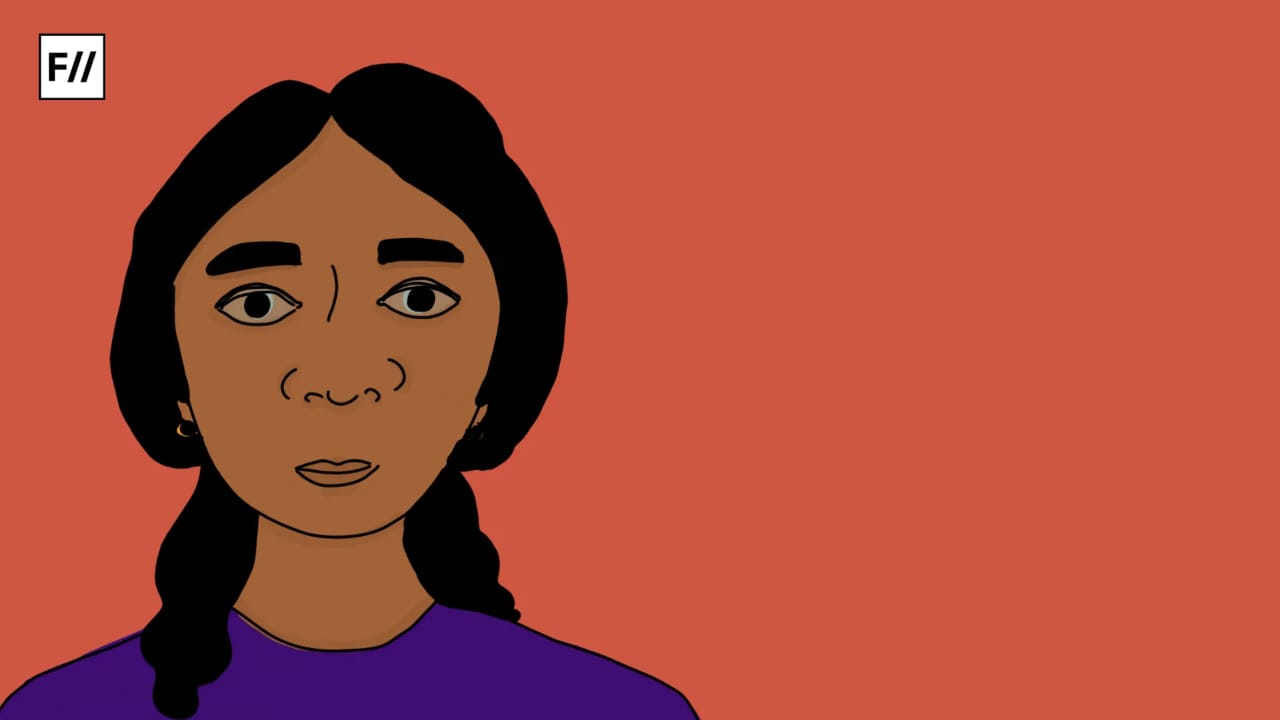On June 11, two lesbian women committed suicide with a child, daughter of one of the women, in Ahmedabad. They left two suicide notes both of which carried the same message – “We are leaving this world which will never allow us to be one.”
What followed this incident was extremely insensitive news media coverage of it, which instead of focusing on the kind of prejudice and practices that create conditions of ostracization for queer couples, dwelt on the details of the suicide.
“We are leaving this world which will never allow us to be one.”
The structuring of the headlines in ways which centralized the fact that the women included a child in their attempt to suicide was deeply problematic. It adds to the practice of demonizing queer couples and fails to acknowledge the harassment queer couples face at the hands of families, community and the police.

(Headlines have been taken from NDTV, TimesNow News and Hindustan Times respectively.)
This incident is part of larger pattern of instances of harassment, marginalisation and suicides amongst queer couples.
Laws on kidnapping, wrongful confinement and abduction are often used to control lesbian couples. Moreover, many queer women are subjected to ‘corrective rape’ cure to pressure them into marriage. Maya Urm Aher, a transgender rights activist, has noted how prevalent ‘corrective rape’ in rural areas is and how it constitutes the main reason as to why many women don’t speak up. This story finally is also symptomatic of the fact that risks of depression are much higher in the case of queer communities.
Laws on kidnapping, wrongful confinement and abduction are often used to control lesbian couples.
The reluctance to attack the stigma attached to the lives of queer women in these news stories is deeply troubling. The problematic nature of this coverage has been noted by some like Queer Abad who also suggested some alternate headlines.
What lies behind this coverage of two hapless queer women, remembered only in their death and agony, is the history of how the news media has looked at queer women mainly through a lens of tragedy. They have focused primarily on stories of queer women pushed to death or a life of humiliation and they become our initial and only point of reference for knowing about the lives of queer women.
Here are some examples of such stories – in 2001 two girls in Kerala were found dead after facing rejection from their families. In Chennai, in 2008, due to efforts from their families to separate them – two women committed suicide. In 2011, in Nandigram in West Bengal, the same fate befell two other women. In 2013, two young women fled to Bangalore from Kerala to escape their disapproving families.
The question of representation is linked closely to how and in what cases queer women have been granted visibility in media. The situation has been widely different for queer men and women. Naisargi Dave, an anthropologist and scholar of queer activism, has argued that the term ‘lesbian’ itself arrived later than ‘gay’ in Indian mass media.
What lies behind this coverage of two hapless queer women, remembered only in their death and agony, is the history of how the news media has looked at queer women mainly through a lens of tragedy.
Ashok Row Kavi’s coming out interview in Savvy magazine in February 1986 was the first time an Indian man had declared himself publicly to be gay. In Dave’s personal interviews with several Indian gay men she notes how this was a liberating moment of realisation and comfort for several of them. It was a pivotal moment for them personally to find representation and recognition.
The term ‘lesbian’ arrived in the Indian scene for the first time in 1987 with scandalous accounts of marriages, suicides etc. The stories of queer women were in sharp contrast to the affirming and inspiring account of Ashok Kavi. The latter sought to convince, inspire people and ordinary readers with its coverage of Kavi’s unashamed and audacious public statement. Queer women on the other hand never got this grand moment of acknowledgement.
Their stories centred on tragedy, sorrow and just a general sense of awfulness were meant to repel the readers instead of sensitising them towards the stigma that caused these instances of misfortune.
The term ‘lesbian’ arrived in the Indian scene for the first time in 1987 with scandalous accounts of marriages, suicides etc.
The early stories were also focussed primarily on ‘expert analyses’ of experiences of lesbian women. These experiences were studied in relation to rejection at the hands of family and society, seclusion and feelings of utter loneliness, and sorrow.
Apart from sob stories, there are also attempts at click bait narratives circling around family drama, and eloped couples which seem to incite feelings of horror and disgust. An extreme example of this can be found here.
The central problem with ‘victim narratives’ is that in their preoccupation with the sadness of the incidents they suppress the voices of queer women. They become passive subjects of either pity or disgust instead of active subjects capable of telling their own stories. It is a form of dehumanization to deny people their own voice and not see them as full individuals who went through a myriad of experiences.
In the Ahmedabad instance also, the coverage casts off the women as voiceless victims. Not only does such thoughtless coverage denies them dignity in their death but ignores the deeper story of pain, rejection and longing underlying their words –“We are leaving this world which will never allow us to be one.”
As seen from the case of Ashok Kavi, positive messages based on ideas of hope and assertion can be extremely comforting for queer people. We need to see similar stories of camaraderie, love, friendship, confident expression and resilience for queer women. It is central to not only how others see their lives but also how other queer women seek ideas of how their lives can be like.
Also read: Let’s Talk About Alternate Safe Spaces For Queer Women In India
Featured Image Credit: Times of India (modified from original)




